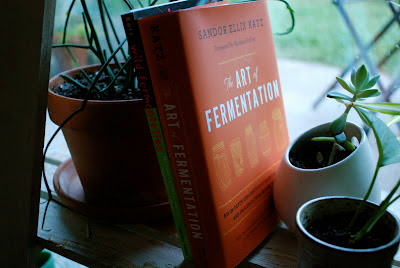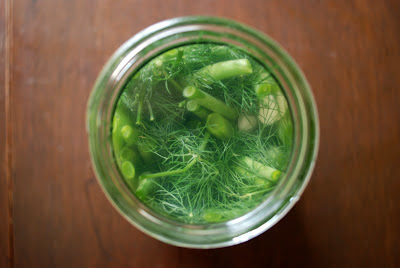We are excited to welcome Luke Freeman, Natalie's other half, to this week's Tend. Luke is an organic farmer & educator on the Arkansas-Oklahoma border at the Kerr Center for Sustainable Agriculture. Luke spends his days building compost piles, planting vegetables, tending to six acres of certified organic land, preparing compost tea, caring for his red wiggler worms & teaching others about organic practices. In addition to farming, Luke enjoys good beer, bicycling, a long run, & spending time with Natalie in the kitchen.
------------------------
Recently, I've been obsessed with fermentation. And I'm not talking about beer or wine. I've been fermenting vegetables.
The source of this fascination came from the artisan bakery where my wife and I used to work. The cooks there made delicious sauerkraut and kim chi for reuben and bahn mi sandwiches. I remember five-gallon buckets stuffed full of shredded cabbage with plates on top to weigh it all down.
There was a book those cooks referred to in their fermentation explorations: Wild Fermentation by Sandor Ellix Katz. This was the book I turned to when I was eager to explore the world of fermented foods. Soon I discovered that Katz was publishing a more extensive guide, titled The Art of Fermentation, which I excitedly bought for myself. These two books have been my go-to guides when it comes to vegetable ferments, and they extend much further into grains, milk, beans, and meats.
Fermenting vegetables is a great way to preserve an abundant harvest. On the farm where I work, we have been harvesting bushels of green beans, which I have been fermenting to make delicious "Dilly Bean Pickles." Unlike traditional canning, which requires sterilization and high-heat, fermentation takes advantage of beneficial bacteria that acidify and "pickle" your produce at room temperature. The key is to provide an environment that encourages the growth of these lactic acid bacteria and discourages the growth of molds and pathogenic organisms.
In the case of vegetable ferments, it is as simple as soaking the vegetables in a salty brine or generously sprinkling them with salt and then packing them into a jar so that they are submerged in their own juices. At this point, the lactic acid bacteria go to work acidifying your fermentation and producing byproducts like alcohols and carbon dioxide--making your fermented vegetables delicious! You can eat the ferment at any time during the process, but when it tastes just right you can set the jar in the fridge to halt the activity of those bacteria. At cool temperatures, fermented vegetables can last for years!
These lactic acid bacteria that ferment your garden produce are also really good for you. They are some of the microorganisms that live in your intestines and help you digest food. The Lactobacillus genus of lactic acid bacteria are that same organisms that make yogurt so good for you. They have actually been shown to reduce anxiety, stress, and depression when present in the gut. These are some pretty cool microbes!
Happy fermentations!







I didn't know he had a new book. It's on hold at the library now so thanks!
ReplyDeleteThank you Natalie and Luke! Fermentation sounds interesting, and when our green beans are ready, I'd like to try this.
ReplyDeleteLuke, great post! I wish for some "recipes" of sorts, but I'll have to see if my library has some of those books. Take care, we miss you guys so much!
ReplyDeletewhat a great post, Luke! Headed to the library today!!
ReplyDelete
ReplyDeleteNICE for giving a chance to share ideas for your comuty i really thanks for that great post.
visit our website